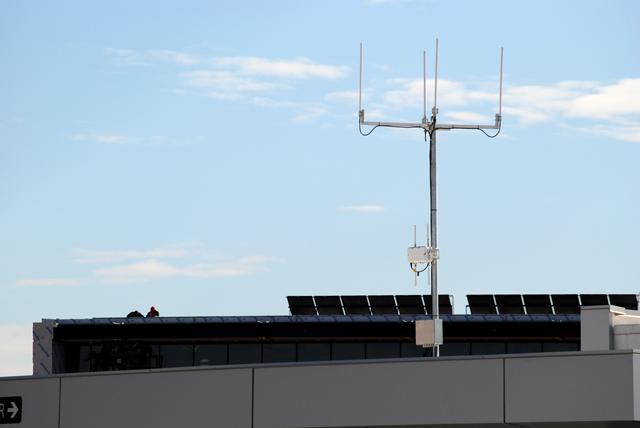
© NCSU Student Media
This CentMesh node is located atop the Centennial Parking Deck, across the road from the Hunt Library, where construction workers work on the roof. Each node consists of two parts. The top antenna array, connected to a computer on the ground, is part of the CentMesh network, transmitting and receiving signals. The other small box is a commercial Cisco router, which will be used to create a network that the open source CentMesh network can be compared to. Photo by Michael Pratt
Centennial Campus has been covered with a “mesh,” but this invisible one consists of an outdoor Wi-Fi network, accessible through untethered mobile devices. This project called CentMesh , short for Centennial Outdoor Wireless Mesh Network, is a test bed for research and education and one of the first Wi-Fi meshes in the country, allowing the researchers to modify or rewrite the codes to meet their requirements.
The project started with an initial award in July 2008, with sponsoring from the Army Research Office.
John Streck, the director of operations from the computer science and engineering department, is one of the core team members in the implementation of the CentMesh project.
“We followed a gradual development cycle, with three distinct phases. In the first phase, a laboratory version was developed. In the second phase, we developed a push-cart version and tested it outdoors. The third and final phase consists of the pole deployment,” Streck said.
CentMesh allows both students and faculty to use it as a Wi-Fi source. Additionally, network researchers use it in their investigation in improving Wi-Fi coverage.
According to Dennis Kekas, associate vice chancellor of the College of Engineering, CentMesh is a perfect example of using the research park as a “living laboratory.”
“Centennial Campus is a mini-city of buildings, employees, students and amenities, and an integrated network system is an excellent way of keeping such a community closely connected,” Kekas said.
The CentMesh project differs from the current Wi-Fi system available on the Centennial Campus in many different ways.
“From a user perspective, CentMesh is primarily designed to cover the outdoor areas, while the existing coverage on the Centennial Campus is focused on the indoor areas,” Streck said. “From an implementation perspective, the production part of CentMesh is based on mesh technology, which is quite different from the existing Wi-Fi infrastructure.”
Being an open source, researchers can modify and make instant changes to the network, modifying the codes of the Wi-Fi system.
This project underwent a thorough series of trials before the finalized network was opened for public use. Rudra Dutta and Mihail Sichitiu, both of whom are associate professors in the computer engineering department, played a lead role in implementing the finalized version of CentMesh after a rigorous series of trials.
“We spent a lot of time carefully planning and testing the software, and we only moved to this final phase once we were confident that all software and placement of the nodes was correct,” Streck said.
According to the CentMesh website, the vision for the Centennial Campus has been crafted by academics and researchers. The recognized aim of the campus is to be a “Living Laboratory,” providing a mission and goal of the campus to actively aiding researchers and educators.
Further plans on expanding the area of CentMesh to main campus have been considered.
“We believe that, in time, the CentMesh can be further extended in other locations, and the main campus is one such possible location,” Streck said. “Different locations offer different advantages and challenges, and the N.C. State main campus is only one such possible location.”